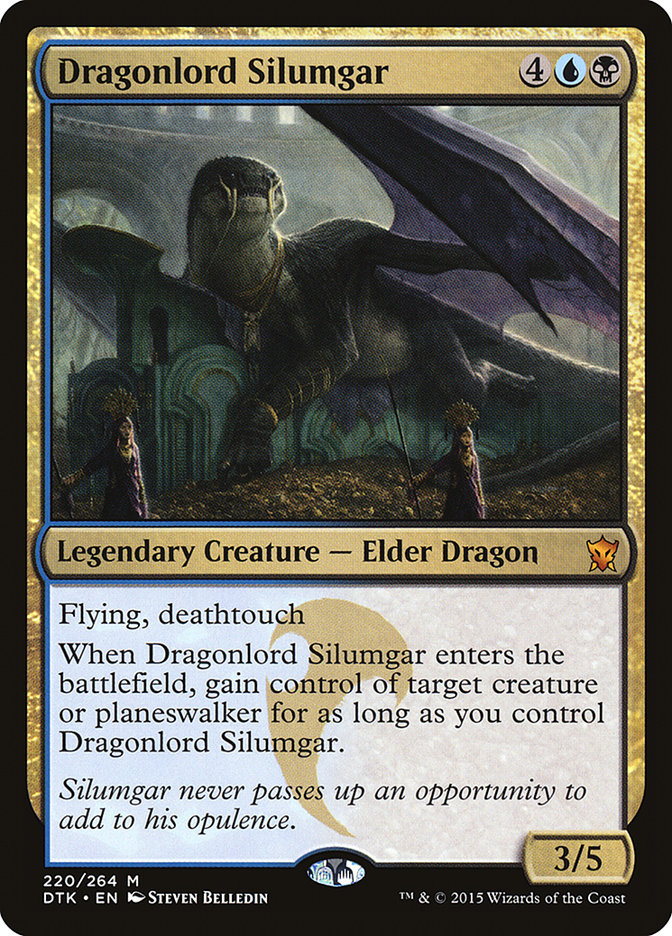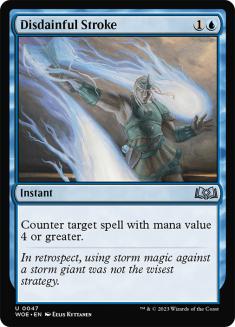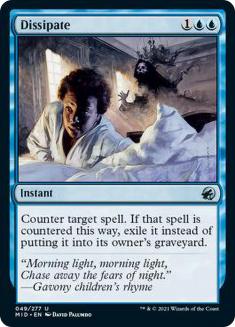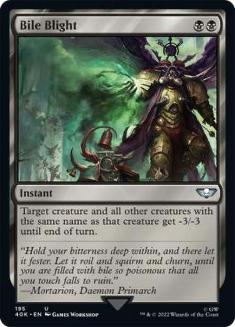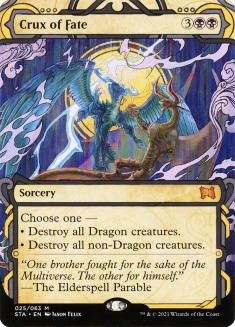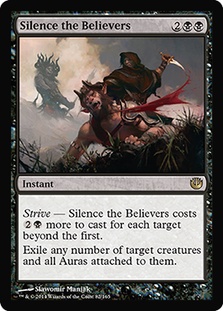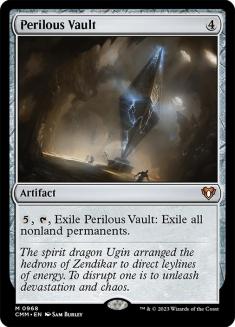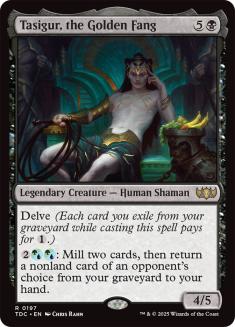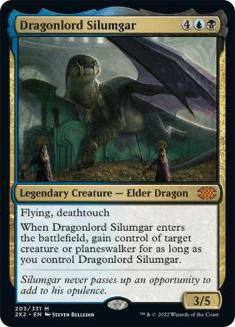I didn’t expect to be writing this article because my hopes weren’t that high for Pro Tour Dragons of Tarkir. Historically I have never been very good at
new Draft formats. The last time I did better than 3-3 in Limited during a Pro Tour was in 2010 where I went 5-1 in San Diego. PTDTK was my 13th Pro Tour,
so eleven out of twelve unsuccessful Limited performances had me down going into the event.
Unfortunately, I didn’t feel any more confident in Constructed. My major experience was with U/B Control (I won the last PTQ of the season to qualify for
PTDTK), but it didn’t yet feature Dragons of Tarkir. This didn’t bode well, as new Constructed formats are rarely defined going into a Pro Tour
and this hurts a control deck’s chances of doing well. How can you fight something appropriately if you don’t even know what you’re going up against?
My other go-to deck was Abzan Control, but it didn’t feel like the green devotion matchups were great and actually felt a lot like playing U/B Control at
times – only worse since it was also weak to Red Aggro. Despite this uncertainty, I decided to play U/B Control because it was what I had the most
experience with.
Shaky in my Limited game and unsure on my Constructed deck selection, I also had to take four days off of work to attend the Pro Tour. This meant I had a
ton to do before I left, so I didn’t have a ton of time to test out my hunches and put my mind at rest
“Why am I even going to this tournament?” was all I could think.
Even though I was pessimistic about my chances, I generally do better when I don’t expect anything; that’s probably not a coincidence, as the pressure to
succeed is removed. I went across the Atlantic to play some matches and decided that whatever happened, happened. If I did poorly, at least I got to
explore Belgium right?
Creatures (2)
Planeswalkers (1)
Lands (27)
Spells (30)

My sideboard wasn’t amazing, but I felt very confident about the maindeck. The players who saw my deck said it looked like the best version of U/B Control
I could play, and some even considered audibling to it. After that feedback, I felt a little better about my chances; I also didn’t hear any buzz about a
secret deck that was being widely played that would crush me. Even though I didn’t play any games with my deck beforehand, I still did my homework and
studied all of the lists that came out of the Open Series circuit and read plenty of articles to prepare.
My major regret with this build of U/B Control is that I tried hard, but not hard enough, to beat Red Aggro. I had 3 Drown in Sorrow, 1 Pharika’s Cure, and
1 Jorubai Murk Lurker for the matchup, but after my round against Gaudenis Vidugiris where I was thoroughly dismantled despite having five narrow cards in
my sideboard, it was clear that it wasn’t enough. Game 1 was so bad against Mono-Red that I needed to convincingly crush it in games 2 and 3 to have a
chance. If I take my matchup from 20% to 50% after sideboard, math dictates that I will still lose one of the two sideboarded games on average and,
therefore, lose the match. Therefore, I should have had more courage to either sacrifice the Mono-Red matchup altogether and prepare more for other decks,
or address the matchup appropriately.
Looking back, I believe I should have ignored the Red Aggro matchup, as those additional sideboard slots should have been devoted to beating Abzan Aggro.
One thing I did know going into the event, even though I had limited testing, was that no matter what you may think the metagame will look like, people
will always play some form of Abzan. The maindeck Ultimate Prices were fantastic against Green Devotion, but they were clearly awful versus Abzan Aggro
given all their multicolored creatures, so I needed more answers in the sideboard like Encase in Ice, Silence the Believers, and/or Dragonlord Silumgar.
Speaking of Dragonlord Silumgar, I had never cast the card before the Pro Tour, but I quickly learned that it was phenomenal. It is at its best against
green decks, but it especially shines in a deck like U/B Control because so many people sideboard their removal out because most U/B Control decks (unlike
Esper Dragons) don’t win with creatures.
Here’s a brief glimpse into some of my Constructed matches at the Pro Tour:
Round 4: G/R Devotion W: 2-0
I liked the Green Devotion matchups coming into the tournament because I had plenty of cheap and efficient cards like Ultimate Price and Disdainful Stroke
that interact with their expensive threats. The only troublesome cards that Green Devotion typically brings to the table are Genesis Hydra and Nissa,
Worldwaker. Perilous Vault is especially good in this matchup since it stops non-creature permanents like Xenagos and exiles Deathmist Raptor.
Round 5: Abzan Aggro L: 1-2
I flooded in game 3, but fortunately it was the only time it happened during the tournament. Since I had four copies of Anticipate to find my Dig Through
Times and Jace’s Ingenuities, I learned during this match that this take on U/B Control had a more powerful end game previous pre- Dragons of Tarkir iterations. This was also the match where I felt like I had useless red sideboard cards and needed extra removal for Fleecemane
Lion and Rakshasa Deathdealer.
Round 6: Atarka Red L: 0-2
Gaudenis Vidugiris is a great player, and this was my worst matchup by a longshot. Cards like Hero’s Downfall aren’t even great here because decks
with Atarka’s Command typically have eight token-makers in 4 Hordeling Outburst and 4 Dragon Fodder. Encase in Ice is also awkward because they can get
around it by dashing, and it doesn’t help versus Goblin Rabblemaster.
Round 8: U/W Control L: 1-2
Andrew’ Cuneo’s deck was very interesting, as it won games with Secure the Wastes, Dragonlord Ojutai, and Elspeth, Sun’s Champion. I worked on a deck
similar to this a few weeks before the tournament, and it seemed promising.
Game 1 was over in short order, as I drew three lands for the entire game while Cuneo functioned seamlessly. The sideboard games seemed to be fine for me,
but Ashiok wasn’t as good as I had hoped. I made a questionable play that involved me aggressively trying to resolve Ashiok, but a topdecked Dissolve left
me open to a main phase Secure the Wastes for three that ended up killing me over many turns.
I began the event 4-0 and then fell to 5-3 thanks to my poor (2-3) Constructed showing. I could have played better versus Cuneo and got paired against the
unfavorable red matchup with Gaudenis, but my deck still felt great, and I didn’t mulligan a single time. I also noted that I didn’t get paired against
that many green decks on day one, so I felt like there was an opportunity to still do well on day two since I knew there were still plenty of green decks
out there.
Round 13: Atarka Abzan W: 2-0
Thanks to the Anticipates, I was able to go toe-to-toe with Steve Rubin and his super grindy take on Abzan. I found so many copies of Dig Through Time and
Jace’s ingenuity thanks to Anticipate that I almost drew my entire deck during one of the games. Risen Executioner was annoying, and I expect that card see
more play moving forward given what Esper Dragons has done to the metagame, but Perilous Vault gives U/B Control a nice clean answer.
At this point, I was 10-3 but I wasn’t qualified for Pro Tour Magic Origins, so a win in any of the remaining three rounds would put me to at least 11-5,
which is good enough for another invite. I thought of the next round as a PTQ finals with two redos if necessary. At the same time, winning the next two
rounds would allow me to draw into top 8, so clearly there was a lot on the line.
Round 14: Jeskai Tokens L: 0-2
This was my first feature match of the tournament; it had been a while since I played under the lights, but with how Eric Froehlich has been playing
lately, to the lights we went.
I wasn’t ready for maindeck Disdainful Stroke from Efro, and the only two big spells I drew, Ugin, the Spirit Dragon and Dig Through Time, were countered.
The second game was also looking good for me, but the Disdainful Strokes countered my key draw spells yet again, and I was left with too many lands to
operate.
This was a tough loss for me, as I thought I was eliminated from top 8 contention. It also meant I had to win one of the next two rounds to qualify for the
PT again, so the pressure was certainly on.
Round 15: G/B See the Unwritten W: 2-0
This match was surprisingly easy. See the Unwritten is a big sorcery that I could counter with Dissolve, Negate, and Disdainful Stroke, and the black
splash wasn’t great against me because I have plenty of time to stop a Doomwake Giant. I was lucky to not see any Reclamation Sages so my Perilous Vaults
never died to artifact removal throughout both this match and the entire event.
Winning this round felt great, as it meant I was now qualified for the next Pro Tour! Patrick Chapin, someone I’ve known for a while since we’re both from
Michigan, came up to me at the end of the round and said I was still live for top 8 thanks to a lot of unintentional draws. How lucky!
I had another feature match in the final round; Joel Larsson and I both knew we had a shot to top 8 with a win here, but even if tiebreaks didn’t break our
way, it was a guaranteed top 16 finish, good for 15 pro points and $5,000.
Round 16: G/R Dragons W: 2-0
I thought G/R Dragons was going to be a popular deck since Chris VanMeter won the Open Series in Syracuse, and boy was I right. Players around the world
were beginning to discover the power of the Dragon engine thanks to Haven of the Spirit Dragon, but I came plenty prepared. All of the Ultimate Prices and
Disdainful Strokes did exactly what I expected and kept the match under control. Perilous Vault was great, as expected, since there were Outpost Sieges
after sideboard.
I ended the tournament 12-4 thanks to my great 7-1 record on day two. This tournament was very ironic because I have had historically strong Constructed
records at the mixed Pro Tours, but I went 6-0 in Draft! The shoe was on the other foot as the mediocre 6-4 Standard record kept me from a top 8.
It was awesome to be in the running for my second PT top 8, but it was also very disappointing when I found out I was only .07% away in tiebreaks. Going
forward, I still think U/B Control is a good choice even though Esper Dragons is obscenely popular given its results from Grand Prix Krakow.
Coming into the Pro Tour, players had these archetypes on their mind:
-
Abzan Aggro
-
G/R Dragons
-
Abzan Control
-
G/W Devotion
-
Red Aggro
-
U/B Control
Coming out of GP Krakow and SCG Providence, I expect the popular decks to be:
-
Esper Dragons
-
Esper Dragons
-
Esper Dragons
-
Bant Midrange
-
Abzan Aggro
-
Red Aggro
-
Atarka Abzan
-
Jeskai Tokens
-
Whip of Erebos decks
You might be asking yourself, “Kyle, why would I bother with U/B Control since all the cool kids are playing Esper Dragons?”
U/B Control is still a great choice because everyone is scrambling to beat Esper Dragons; it’s rarely a bad choice to attack from left field. Perilous
Vault is very well-positioned as cards like Jeskai Ascendancy, Whip of Erebos, and Mastery of the Unseen are hard to remove for Esper Dragons, and everyone
knows it (only Ugin can kill a resolved artifact or enchantment). Deathmist Raptor can also be annoying for Esper Dragons as there are very few ways to
remove creatures from the game.
It requires different tools to beat Esper Dragons compared to U/B Control, so this metagame shift will help true control mages. The old thinking to beat
Dig Through Time decks was to jam planeswalkers like Nissa and Xenagos, but the Dragons promote a more combat-oriented gameplan. While this is still a good
plan, a turn 5 creature can quickly kill them if they manage to resolve. Decks are also free to play more removal because it isn’t dead against the most
popular control deck. Even though Esper Dragons has five hexproof dragons, they still must respect Murderous Cuts and Hero’s Downfalls for Ojutai.
Here’s the list I would play after the recent metagame changes:
Creatures (1)
Planeswalkers (2)
Lands (27)
Spells (30)

The biggest change for my updated list is the removal suite. I added a Crux of Fate because it’s now good against the control deck of choice as well as
aggressive decks. Ultimate Price is embarrassing against both Abzan Aggro and Esper Dragons, so just a single copy remains in the sideboard. Silence the
Believers is great against Abzan Aggro since it kills Rakshasa Deathdealer, and Deathmist Raptor out of Bant Midrange.
I made a slight change to the counter suite as well:
Out:
In:
This is a good change because Abzan Aggro doesn’t play many four-drops and Dissipate actually counters spells earlier despite it costing an additional
mana. It’s also worth noting that Dissipate exiles Deathmist Raptor since I expect this card to become more popular to prepare for Foul-Tongue Invocation
out of Esper Dragons. In the same regard, removing key spells from the game will hurt Den Protectors too.
I wanted a new win condition in Liliana Vess because Silumgar, the Drifting Death is on the minds of everyone thanks to Esper Dragons. The point of
Silumgar was to have a threat that never died, but now Foul-Tongue Invocation kills it easily. Liliana Vess is good in the control mirror and can also
close a game quickly if left unchecked versus any deck. I have more singletons in this list to take advantage of the -2 ability; I don’t think that
changing my deck for this is too cute because you are also rewarded for a diversity of spells with Dig Through Time already.
You may think it’s strange that I cut Silumgar, the Drifting Death and also added a second Haven of the Spirit Dragon, as the only target for the land is
Ugin. I did this because Esper Dragons plays a maximum of three Hero’s Downfall, so having access to essentially four planeswalkers can be a way to
actually win game 1 instead of just trying to deck them. The Ugin will come into play and exile a dragon and then die to Hero’s Downfall so it can be
returned an extra time. Since game 1 goes so long, you can make changes like this to your deck and have it come up frequently, as decking is the primary
concern.
Speaking of decking, with so many players concentrating on playing Esper, I have cut the fetchlands in favor of more basics. This will hurt my chances at
early Dig Through Times, but thinning your deck of lands is the worst thing you can do in control mirrors as they are all you want to draw. There are even
times where I feel bad casting Anticipate game 1 because it takes a card out of my deck; you need to constantly be concerned about the number of cards in
your library when playing against Esper.
Here’s my sideboard plan versus Esper:
Out:
In:
This isn’t a terribly surprising sideboard plan, as I cut the expensive creature removal spells as well as the Bile Blights that don’t kill anything by
themselves. I now have four discard spells so I can stop the uncounterable Dragonlord’s Prerogatives before they are cast. The hand disruption plan also
allows me to fill the graveyard for both Tasigur and Dig Through Time. In my previous builds this was a problem, as an early Tasigur meant my first Dig
Through Time took longer to cast.
Perilous Vault and Crux of Fate are my only ways to kill Silumgar, the Drifting Death besides Ugin, but the games will speed up after sideboard, so that’s
alright. It’s relevant that Dragonlord Silumgar will be able to stop the Drifting Death in combat thanks to deathtouch, and the opponent will have less
removal to break up that interaction. This also gives you an extra Dragon to return with Haven of the Spirit Dragon.
In game 1, I’m afraid to draw cards, but games 2 and 3 are all about card advantage. Tasigur gives you the ability to land an early threat and run away
with the game, and the opponent can do the same thing. Be mindful of the fact you are cutting black cards for blue cards, which means your mana will
sometimes be constrained in a counter war. The manabase is built assuming Bile Blights are in your deck, so the post-board control games have an incorrect
color distribution.
So there you have it, a deck that is in a good place in the metagame that isn’t named Esper Dragons. Many have made the argument Esper Dragons is the only
control deck to play because it is “the best deck,” but a deck can only hold that title for so long. Like most Standard formats, the true best decks to
play are the ones that are often forgotten–even if just for a second.

